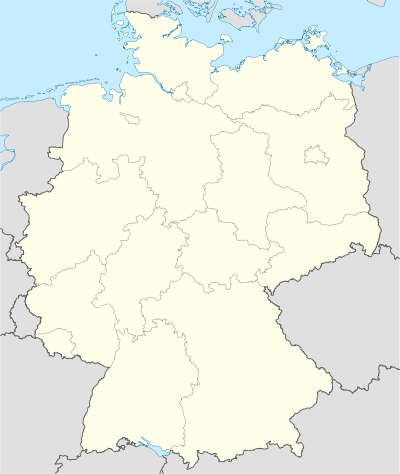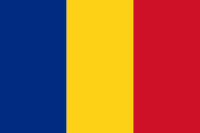Jena
| Jena | |
 |
|
 |
|
 Jena
|
|
| Coordinates | |
| Administration | |
| Country | Germany |
|---|---|
| State | Thuringia |
| District | Urban district |
| Lord Mayor | Albrecht Schröter (SPD) |
| Basic statistics | |
| Area | 114.30 km2 (44.13 sq mi) |
| Elevation | 155 m (509 ft) |
| Population | 104,449 (31 December 2009)[1] |
| - Density | 914 /km2 (2,367 /sq mi) |
| Other information | |
| Time zone | CET/CEST (UTC+1/+2) |
| Licence plate | J |
| Postal codes | 07701–07751 |
| Area code | 03641 |
| Website | www.jena.de |
Jena (German pronunciation: [ˈjeːna]) is a university city in central Germany on the river Saale. With a population of 103,000 it is the second largest city in the federal state of Thuringia, after Erfurt.
Contents |
History
Jena was first mentioned in an 1182 document. In the 11th century it was a possession of the lords of Lobdeburg, but in the following century it developed into an independent market town with laws and magistrates of its own. Economy was based mainly on wine production. In 1286 the Dominicans were established in the city, followed by the Cistercians in 1301.
The margraves of Meißen imposed their authority over Jena in 1331. From 1423 it belonged to Electoral Saxony of the House of Wettin, which had inherited Meißen, remaining with it also after the division of its lands in 1485.
The Protestant Reformation was brought into the city in 1523. In the following years the Dominican and the Carmelite convents were attacked by the townsmen. In 1558, the university (now called the Friedrich Schiller University of Jena) was founded by elector John Frederick the Magnanimous.
For a short period (1670–1690), Jena was the capital of an independent dukedom (Saxe-Jena). In 1692 it was annexed to Saxe-Eisenach and in 1741 to the Duchy (later Grand Duchy) of Saxe-Weimar, to which it belonged until 1918.
At the end of the 18th century the university became the largest and most famous within the German states, and made Jena the center of idealistic philosophy (with professors like Johann Gottlieb Fichte, Georg Wilhelm Friedrich Hegel, Friedrich Schiller and Friedrich Wilhelm Joseph Schelling) and of the early romanticism (with poets like Novalis, the brothers Schlegel and Ludwig Tieck). In 1794 the poets Goethe and Schiller met at the university and established a long lasting friendship.
On 14 October 1806, Napoleon fought and defeated the Prussian army here in the Battle of Jena-Auerstedt. Resistance against the French occupation was strong, especially among the town students, many of whom fought in the Lützow Free Corps in 1813. Two years later the Urburschenschaft fraternity was founded in the city.
At the end of the 19th century, with the building of the railway-line Saalbahn (along the river Saale) from Halle/Leipzig to Nürnberg, Jena became a center for precision machinery, optics and glass making, with the formation of the world famous companies Carl Zeiss Jena and Schott Jenaer Glaswerk, by Carl Zeiss, Ernst Abbe and Otto Schott.
In 1945, towards the end of World War II, Jena was heavily bombed by the American and British Allies. 153 people were killed and most of the medieval town centre was destroyed (though restored after the end of the war).
Part of the State of Thuringia from its foundation in 1920 on, it was incorporated into the German Democratic Republic in 1949 and its district of Gera in 1952. Since 1990, the city of Jena has been a part of the Free State of Thuringia in the united Federal Republic of Germany.
Economy
Today Jena is a manufacturing city, specializing in precision machinery, pharmaceuticals, optics and photographic equipment, and is home to the famous Zeiss optics plant. In 1926, the world's first modern planetarium was built by the Zeiss company in the Damenviertel district of the town.
Today the city's economy diversifies into bioinformatics, biotechnology, software and photonics. The metropolitan area of Jena is among Germany's 50 fastest growing regions, with many internationally renowned research institutes and companies, a comparatively low unemployment, and a very young population structure. Jena was awarded with the title "Stadt der Wissenschaft" (city of science) by the Stifterverband für die Deutsche Wissenschaft, a German science association, in 2008.





Main sights
- The 13th century Town Hall ("Rathaus"). It has an astronomical clock featuring the "Snatching Hans" ("Schnapphans").
- The Gothic St. Michael's Church ("Michaelskirche", 1506). It has a bronze slab of Martin Luther's tomb
- Monument to John Frederick the Magnanimous (1905–08), in the Market Square
- The Old Castle and numerous towers from the medieval fortifications, including the Powder Tower (13th-14th centuries)
- House of Friedrich Schiller and his Wedding Church.
- The Botanischer Garten Jena, founded in 1580, the second oldest botanical garden in Germany
- Jen-Tower, a research edifice built in GDR times. There is a restaurant and viewing platform at the 27th floor.
In the neighbourhood are the Dornburg Castles and the Kapellendorf Moated Castle.
Public transport
- The city is served by an extensive network of buses and trams run by the "Jenah" organization (a pun on Jena and Nahverkehr, German for public transport).
- busses of the JES Verkehrsgesellschaft connect Jena with cities and villages in the region
- The high-speed railway line from Berlin to Munich calls at the Jena-Paradies station just to the east of the city centre (like all other trains on the north-south-relation); trains from Erfurt and further west arrive at the Westbahnhof just west of the city centre (like all other trains on the east-west-relation).
- The nearest airports to Jena are Leipzig-Altenburg Airport and Erfurt Airport. However international visitors normally arrive at Frankfurt, Berlin or Munich airports, from all of which there are convenient train connections to Jena.
Colleges, universities and research institutes
- The Friedrich Schiller University of Jena was founded in 1558 as the "Collegium Jenense".
- The University of Applied Sciences (Fachhochschule Jena) was founded in 1991.
- The Max Planck Institute for Chemical Ecology is an important research center and offers a Ph.D. program.
- The Max Planck Institute of Economics
- The Max Planck Institute for Biogeochemistry
- The Institute of Photonic Technology
- The Fraunhofer Institute for Applied Optics and Precision Engineering (IOF)
- INNOVENT - one of the biggest private research centers in Germany
- The Leibniz Institute for Age Research
- The Leibniz Institute for Natural Product Research and Infection Biology
- Friedrich-Löffler-Institute of Bacterial Infections and Zoonoses
- Friedrich-Löffler-Institute of Molecular Pathogenesis
- The Jena Center for Bioinformatics
Museums
- Optical Museum Jena - history of optical instruments
- Schott GlassMuseum - production and usage of glass
- Citymuseum Göhre - urban history of Jena
- Botanical Garden
- Phyletic Museum - phylogeny and evolutionary theory
- Romanticism House - literature
- Memorial to Goethe - literature
- Oriental Coin Cabinet Jena - Oriental history, numismatics
- Schott Villa - history of the Jena glassworks and of Otto Schott and his family
Culture

- The Jenaer Philharmonie is the largest independent symphony orchestra in Thuringia.
- Kulturarena: annual music festival held in front of the theatre
Famous citizens and Alumni of the University
- Ernst Abbe, physicist, social reformer, partner of Carl Zeiss and Otto Schott
- Anton Wilhelm Amo, African Philosopher
- Johannes R. Becher, poet and politician
- Hans Berger, discoverer of human EEG and two-time Nobel Prize nominee
- Bernhard, Prince of the Netherlands
- Johann Friedrich Blumenbach, influential German naturalist, doctor, comparative anatomist and physiologist
- Johann Gottfried Eichhorn, orientalist and Protestant theologian of the Enlightenment
- Robert Enke, German footballer
- Walter Eucken, founder of neoliberal economic theory
- Rudolf Eucken, philosopher and the winner of the 1908 Nobel Prize for Literature
- Johann Gottlieb Fichte, philosopher and early German nationalist
- Gottlob Frege, mathematician, logician, and philosopher
- Friedrich Wilhelm August Fröbel, inventor of the kindergarten
- Johann Wolfgang Goethe, poet/writer
- Ernst Haeckel, German evolutionary biologist/zoologist
- G. W. F. Hegel, philosopher
- Friedrich Hölderlin, poet
- Martin Luther, reformer
- Philipp Melanchthon, theologian
- Friedrich Wilhelm Nietzsche, philosopher
- Novalis, poet
- Max Reger, composer, pianist, professor and conductor
- Friedrich Schelling
- Friedrich Schiller, poet/writer
- Caroline Böhmer Schlegel Schelling
- Wilhelm Schlegel, philosopher
- Bernd Schneider, German footballer
- Otto Schott, inventor of fireproof glass, founder of the Schott glass works
- Reinhard Johannes Sorge, German poet, dramatist, and Roman Catholic convert
- Johann Gustav Stickel, orientalist
- Kurt Tucholsky, writer
- Carl Zeiss, founder of the Zeiss company
International relations
Jena is twinned with:
 Porto, Portugal[2]
Porto, Portugal[2] Lugoj, Romania, since 1983
Lugoj, Romania, since 1983 Erlangen, Germany, since 1987
Erlangen, Germany, since 1987 San Marcos, Nicaragua, since 1996
San Marcos, Nicaragua, since 1996 Aubervilliers, France, since 1999
Aubervilliers, France, since 1999 Berkeley, USA
Berkeley, USA
External links
- Jena travel guide from Wikitravel
- Official Homepage of Jena (German) (English)
- Jena: pictures
- Images from Jena, Germany
- Jenah local public transport information (German)
- Fachhochschule Jena (English) (German)
- Friedrich-Schiller-University Jena
- Oriental Coin Cabinet of the Friedrich-Schiller-University (German)
- Maps
- Kulturarena, official homepage (English) (German) (French) (Russian)
- Local News, Videos and Blogs from Jena (German)
- Local News, Community and Events from Jena (German)
- Jena Trams (English) (Russian)
- Tramway in Jena (English) (German)
References
- Notes
- ↑ "Bevölkerung nach Gemeinden, erfüllenden Gemeinden und Verwaltungsgemeinschaften" (in German). Thüringer Landesamt für Statistik. 31 December 2009. http://www.statistik.thueringen.de/seite.asp?aktiv=dat01&startbei=datenbank/default2.asp.
- ↑ "International Relations of the City of Porto". © 2006-2009 Municipal Directorateofthe PresidencyServices InternationalRelationsOffice. http://www.cm-porto.pt/document/449218/481584.pdf. Retrieved 2009-07-10.
|
||||||||||||||
|
||||||||